So you're thinking "just use a tube and butane dipshit", that's OK this is just stuff lying around the house for me. The gear is common and basic, and the whole procedure here is as simple as it gets. I wanted to show this all somewhere because glass is not necessarily expensive, and petroleum ether is simpler for me to recycle than lower boiling solvents. I did this because the Borg attacked post-frost a couple weeks from harvest, and because the toluene and petroleum ether extractions I've done lately were for THCA. Those THCA yields were disappointing; the chemistry literature says decarboxylate for total cannabinoid yield, at least when using nonpolar solvent. The decarboxylation conditions for this experiment were ideal for yield: buds were air-dried for a week and put in a preheated 225F oven for 2 hours. They would have yielded more than 4 grams of oil if they were better buds. The herb was never weighed.
 This is a 24/40-55/50 Soxhlet apparatus packed full with the same shredded non-sticky buds earlier this weekend. A small amount of green material came out in the first couple mls., it should have been discarded but this is not easy with this apparatus because it empties rapidly once it starts. Otherwise the RBF contents would be yellow instead of yellow-green.
This is a 24/40-55/50 Soxhlet apparatus packed full with the same shredded non-sticky buds earlier this weekend. A small amount of green material came out in the first couple mls., it should have been discarded but this is not easy with this apparatus because it empties rapidly once it starts. Otherwise the RBF contents would be yellow instead of yellow-green.
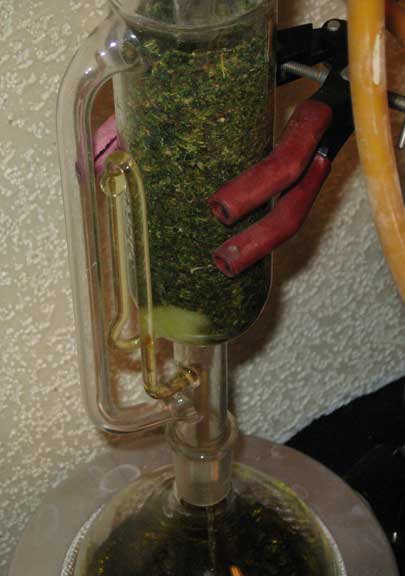 The strongly boiling solvent in the RBF goes through the Soxhlet's sidearm as vapor and is then mostly condensed immediately, around the outside bottom of the condenser here just above the doobage. Some ice in the condenser water is not unwise since this will be going on for a while and this solvent is pretty volatile. As the body fills, the level in the tube goes over the top of the bend and the ensuing vacuum from the falling column of solvent sucks the whole thing dry, every 10-15 minutes, and in the picture. Whoosh until the yellow is all gone.
The strongly boiling solvent in the RBF goes through the Soxhlet's sidearm as vapor and is then mostly condensed immediately, around the outside bottom of the condenser here just above the doobage. Some ice in the condenser water is not unwise since this will be going on for a while and this solvent is pretty volatile. As the body fills, the level in the tube goes over the top of the bend and the ensuing vacuum from the falling column of solvent sucks the whole thing dry, every 10-15 minutes, and in the picture. Whoosh until the yellow is all gone.
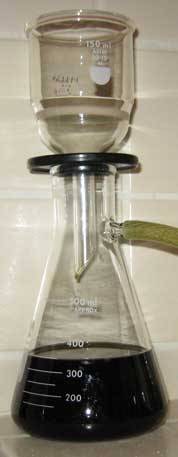 Here is a fritted glass Buchner-type funnel and vacuum filtering flask. The solvent is not really this dark. A fritted funnel with a ground glass joint and vacuum barb, along with an RBF, is the best setup for this. Most commonly seen is bored-out rubber stoppers instead of this black rubber whatsit, around a real Buchner's stem (with filter paper and washed sand or diatomaceous earth on top when you only want the filtrate like here), and the vacuum flask shown.
Here is a fritted glass Buchner-type funnel and vacuum filtering flask. The solvent is not really this dark. A fritted funnel with a ground glass joint and vacuum barb, along with an RBF, is the best setup for this. Most commonly seen is bored-out rubber stoppers instead of this black rubber whatsit, around a real Buchner's stem (with filter paper and washed sand or diatomaceous earth on top when you only want the filtrate like here), and the vacuum flask shown.
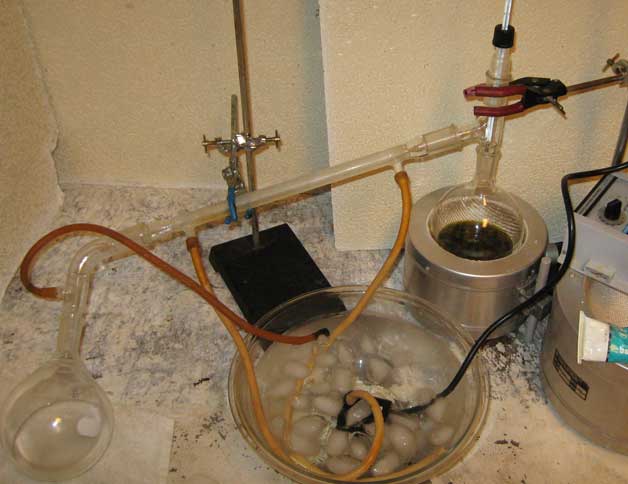 Vacuum distillation with a faucet aspirator would require good cooling for recovering this b.p. of solvent. An HVAC pump would probably require a dry ice condenser to not kill the pump by fouling its oil, not to mention that I'd rather not find out how dangerous using flammables in HVAC systems not rated for them is. I could use the rotavap but they don't last forever. Simple distillation is simple, and the solvent came off at 65C. The only apparatus change from the picture for vacuum distillation is the vacuum and a capillary tube instead of a thermometer.
Vacuum distillation with a faucet aspirator would require good cooling for recovering this b.p. of solvent. An HVAC pump would probably require a dry ice condenser to not kill the pump by fouling its oil, not to mention that I'd rather not find out how dangerous using flammables in HVAC systems not rated for them is. I could use the rotavap but they don't last forever. Simple distillation is simple, and the solvent came off at 65C. The only apparatus change from the picture for vacuum distillation is the vacuum and a capillary tube instead of a thermometer.
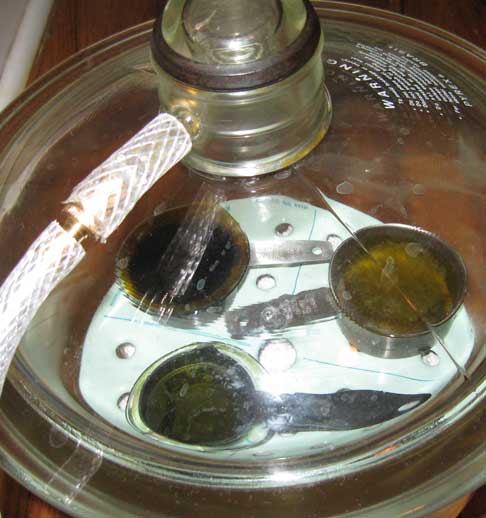 The RBF contents were poured on the watch glass at upper left before it boiled down too thick. Flask washings of small portions of Everclear were put on two others. These are here inside the vacuum desiccator. The lid is 2 pieces, the top part with the barb can turn and seal the inside by cutting off the port. The vacuum inside is max aspirator pull, it's a good vacuum with the low tap water temperature now. The petroleum ether was boiling off really good for couple minutes, but couldn't be seen in the closeups I took. The ethanol was gone after a couple hours but I repurged twice anyways. The oil only climbs the glass when I try to smoke it in Pyrex tubing. I usually mixed extracts with shake anyways.
The RBF contents were poured on the watch glass at upper left before it boiled down too thick. Flask washings of small portions of Everclear were put on two others. These are here inside the vacuum desiccator. The lid is 2 pieces, the top part with the barb can turn and seal the inside by cutting off the port. The vacuum inside is max aspirator pull, it's a good vacuum with the low tap water temperature now. The petroleum ether was boiling off really good for couple minutes, but couldn't be seen in the closeups I took. The ethanol was gone after a couple hours but I repurged twice anyways. The oil only climbs the glass when I try to smoke it in Pyrex tubing. I usually mixed extracts with shake anyways.
 Everything used for this could be bought for $200-250 before shipping, at non-competitive auctions.
Everything used for this could be bought for $200-250 before shipping, at non-competitive auctions.
You are using an out of date browser. It may not display this or other websites correctly.
You should upgrade or use an alternative browser.
You should upgrade or use an alternative browser.
An extraction of decarboxylated buds with lab glass and solvent recycling.
- Thread starter G.O. Joe
- Start date
It won't be a typical BHO product, here this ends with an unappealing oil, and I don't think people doing BHO will want to decarb regardless unless they want to do something with oil. I'm not recommending anything, it was just an experiment with buds that most people would throw away anyways.
your glasswear is awsome, although my first thought was "meth lab" its still super-awsome, reminds me of chem back in college.
Good post bro!
Do I understand that your final purge under vacuum using a faucet aspirator, works well at 65C/149F?
May I ask if the puddle is molten at that temperature and pressure?
I have noted similar recovery issues under vacuum. Any links to information for achieving the high rate of recovery under vacuum, that is easily achieved with simple whiskey still technology?
Do I understand that your final purge under vacuum using a faucet aspirator, works well at 65C/149F?
May I ask if the puddle is molten at that temperature and pressure?
I have noted similar recovery issues under vacuum. Any links to information for achieving the high rate of recovery under vacuum, that is easily achieved with simple whiskey still technology?
Any links to information for achieving the high rate of recovery under vacuum, that is easily achieved with simple whiskey still technology?
http://www.amazon.com/gp/product/0470494379
http://www.amazon.com/gp/product/0070571864
Any video or .edu site you can find with a Google search of whatever keywords it is that you are interested in. Once you learn and once you've done everything associated with distillation, then you understand.
Rotary evaporators like mine are used for removing large volumes of solvent with speed. Throughput is limited by the ability to condense under vacuum so much solvent vapor so quickly, i.e. how low a temperature you are providing in the condenser and how efficient your condenser is. This is the same for all distillation, when you have a high boiler in solvent. When much solvent is distilled quickly under vacuum, you must also provide a lot of heat to vaporize it, this heat will be lost quickly. On my model Buchi there is a little tube that leads from a port in a glass stopper at the top of the condenser to the rotating evaporation flask; connect the port with tubing to more of whatever and turn the stopper under vacuum - more liquid to be distilled is sucked in going straight to the pot - then close the port. You never have to stop the machine. In the absence of flask rotation putting your solvent as a film on glass heated above the boiling point of the flask mixture by the bath, vigorous stirring can be applied.
The vacuum purge was at room temperature, desiccators aren't meant to be heated. It is boiling inside the desiccator because of the vacuum. 65C was the atmospheric boiling point of the locally-sourced-non-OTC-product petroleum ether. Distillation was stopped because I wanted to get the product out of the flask. The vacuum purge seems to go well but if there was residual solvent it would be difficult to tell, and harmless in this case. It started boiling off immediately, and when the desiccator was first opened after 4 hours everything seemed gone. I could have put the watch glass in an oven for a while to make sure, but vacuum was reapplied instead. This oil having no THCA, it is a bit runny, so the solvent should escape without too much forcing.
Aspirators are limited to the vapor pressure of the water running through it, which depends on the temperature. This one is from Nalgene and cost me maybe $10 new, with the splash tube and ball valve. You can see that I did not buy a nice adapter from 3/8" NPT lab faucet thread to home faucet thread, I made a bad one.
I have been making foil "fieldpipes" with 4x5" pieces of foil and a pencil on occasion since I was 14, these are perfect for oil/shake mix. A little goes a long way, the taste is between hash and denatured alcohol hash oil of bygone extractions. Punch is hard but short.
eloquentsoution
Member
wish you lived nearby g.o.joe! love your post.
i would prefer you to vaporize your oil using one of my nice glass pieces tho....
i would prefer you to vaporize your oil using one of my nice glass pieces tho....
Very thorough and informative post. Your glass is inspirational and if such can truely be had for $2-250.00 X-shipping (heavy insured even), hmmm . . . I may stop searching for the old O'Keif X-tractor I never had the courage to use in the first place.
Naw, I probably blow myself to kingdom-come either way.
Still, memories of early '70's Hash & Honey Oil haunt me -- like smeared onto cigarettes and puffed during premere of "The Exorcist" back when those beautiful, gigantic theaters they've since divided into eights still all had a Smoking Section (@50 cents extra).
The perfect pick-me-up about an hour in when the bud started to wear a bit thin.
Funniest movie I ever saw -- if I remember right.
Naw, I probably blow myself to kingdom-come either way.
Still, memories of early '70's Hash & Honey Oil haunt me -- like smeared onto cigarettes and puffed during premere of "The Exorcist" back when those beautiful, gigantic theaters they've since divided into eights still all had a Smoking Section (@50 cents extra).
The perfect pick-me-up about an hour in when the bud started to wear a bit thin.
Funniest movie I ever saw -- if I remember right.
http://www.amazon.com/gp/product/0470494379
http://www.amazon.com/gp/product/0070571864
Any video or .edu site you can find with a Google search of whatever keywords it is that you are interested in. Once you learn and once you've done everything associated with distillation, then you understand.
Rotary evaporators like mine are used for removing large volumes of solvent with speed. Throughput is limited by the ability to condense under vacuum so much solvent vapor so quickly, i.e. how low a temperature you are providing in the condenser and how efficient your condenser is. This is the same for all distillation, when you have a high boiler in solvent. When much solvent is distilled quickly under vacuum, you must also provide a lot of heat to vaporize it, this heat will be lost quickly. On my model Buchi there is a little tube that leads from a port in a glass stopper at the top of the condenser to the rotating evaporation flask; connect the port with tubing to more of whatever and turn the stopper under vacuum - more liquid to be distilled is sucked in going straight to the pot - then close the port. You never have to stop the machine. In the absence of flask rotation putting your solvent as a film on glass heated above the boiling point of the flask mixture by the bath, vigorous stirring can be applied.
The vacuum purge was at room temperature, desiccators aren't meant to be heated. It is boiling inside the desiccator because of the vacuum. 65C was the atmospheric boiling point of the locally-sourced-non-OTC-product petroleum ether. Distillation was stopped because I wanted to get the product out of the flask. The vacuum purge seems to go well but if there was residual solvent it would be difficult to tell, and harmless in this case. It started boiling off immediately, and when the desiccator was first opened after 4 hours everything seemed gone. I could have put the watch glass in an oven for a while to make sure, but vacuum was reapplied instead. This oil having no THCA, it is a bit runny, so the solvent should escape without too much forcing.
Aspirators are limited to the vapor pressure of the water running through it, which depends on the temperature. This one is from Nalgene and cost me maybe $10 new, with the splash tube and ball valve. You can see that I did not buy a nice adapter from 3/8" NPT lab faucet thread to home faucet thread, I made a bad one.
I have been making foil "fieldpipes" with 4x5" pieces of foil and a pencil on occasion since I was 14, these are perfect for oil/shake mix. A little goes a long way, the taste is between hash and denatured alcohol hash oil of bygone extractions. Punch is hard but short.
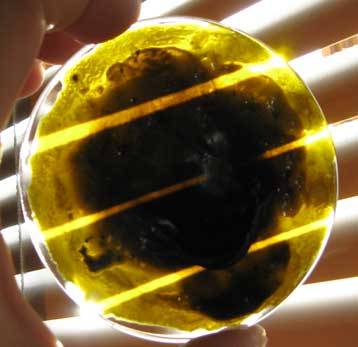
Thanks for the book links bro. I already have the first, but I will pickup a copy of the second.
I was trying to find examples of recondensing the solvent vapors after vacuuming them off, because using an ice water cooled graham and an alhin condenser in series and four ice water cold traps, couldn't keep up with my smaller vacuum pump, so that recovery was significantly lower than with my simple pot still.
So far it still appears I will need something like dry ice or liquid nitrogen to chill my condensers or build/buy something with a whole lot more surface area that what I currently have.
I'm thinking "at auction" is the key word for glass prices. I paid $200 new for the same dessicator that you seem to be using, and thought I got a steal. I previously paid $104 for a smaller polycarbonate one with a caveat against using organic solvents in it.
As you noted, getting finished oil out of a vacuum flask without washing it out with a solvent limits how far down we can reduce it. I have toyed with using a modified stainless pressure cooker that I can also heat while under vacuum, but I can't watch the process.
What I am currently trolling for is a vacuum friendly element or mantle that I can put in the glass dessicator, and power it through the top stopper. I may just make one using Ni Chrome elements, and control it with a variac. I am only looking for 150F or so.
Any feedback on that or any ideas on a better way bro?
Sorry.
Allihns are almost always used as reflux condensers, not distilling. Most Grahams aren't nearly as packed with cooling coils as they could be. I have several West condensers (one shown above), used in series when the need arises.
Look how closely the vapor comes into contact with the cooling coils in the Buchi condenser. There are inner and outer sets of coils and little empty space.
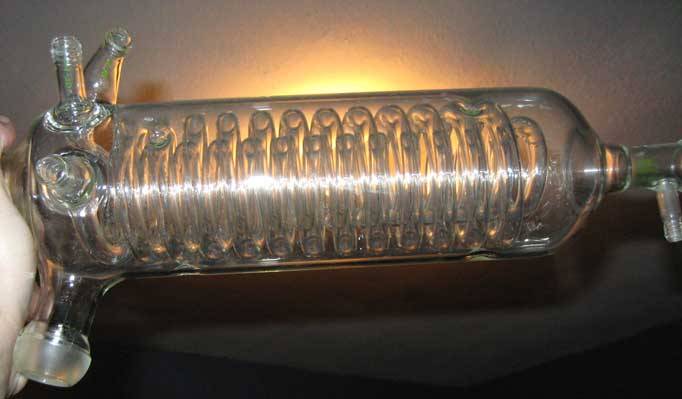
There just isn't anything to say except if you want to do some large scale distillation, do large scale. Big kettle, big condenser. The high price of copper HVAC tubing is a sadness.
There is a 24/40 Friedrichs reflux condenser here to show another way good cooling is done in glass. The vapor must make it through a cooled screw shape. They're preferred reflux condensers. The dessicator was under $30 including shipping; the nice plate shown here, above calcium chloride, was not included. Don't buy new lab equipment without looking at local and internet auction.
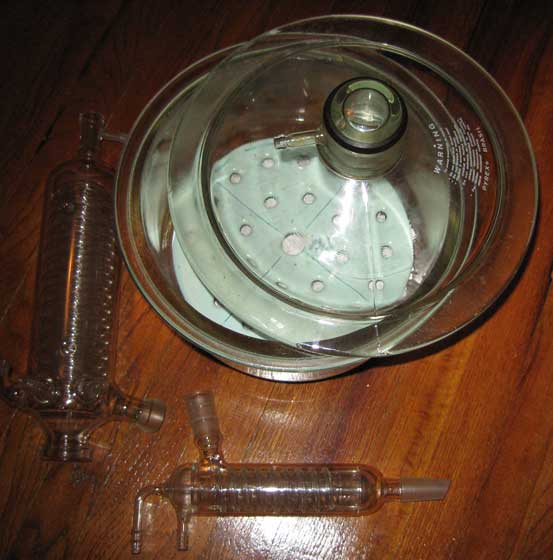
The second and third editions of Zubrick's book can be found as .pdfs, but the newer editions may be more detailed, so I hope you have a newer one.
Krell's Handbook of Laboratory Distillation may tell you a little more than you want to know about distillation, but it's a very good book for those looking for a more detailed treatment than general lab manuals give.
I set it on fire, apply it to the bowl, and inhale.
Allihns are almost always used as reflux condensers, not distilling. Most Grahams aren't nearly as packed with cooling coils as they could be. I have several West condensers (one shown above), used in series when the need arises.
Look how closely the vapor comes into contact with the cooling coils in the Buchi condenser. There are inner and outer sets of coils and little empty space.
There just isn't anything to say except if you want to do some large scale distillation, do large scale. Big kettle, big condenser. The high price of copper HVAC tubing is a sadness.
There is a 24/40 Friedrichs reflux condenser here to show another way good cooling is done in glass. The vapor must make it through a cooled screw shape. They're preferred reflux condensers. The dessicator was under $30 including shipping; the nice plate shown here, above calcium chloride, was not included. Don't buy new lab equipment without looking at local and internet auction.
The second and third editions of Zubrick's book can be found as .pdfs, but the newer editions may be more detailed, so I hope you have a newer one.
Krell's Handbook of Laboratory Distillation may tell you a little more than you want to know about distillation, but it's a very good book for those looking for a more detailed treatment than general lab manuals give.
Hey G.O., how do you introduce the butane to the apparatus?
I set it on fire, apply it to the bowl, and inhale.
Sorry.
Allihns are almost always used as reflux condensers, not distilling. Most Grahams aren't nearly as packed with cooling coils as they could be. I have several West condensers (one shown above), used in series when the need arises.
Look how closely the vapor comes into contact with the cooling coils in the Buchi condenser. There are inner and outer sets of coils and little empty space.
The second and third editions of Zubrick's book can be found as .pdfs, but the newer editions may be more detailed, so I hope you have a newer one.
Krell's Handbook of Laboratory Distillation may tell you a little more than you want to know about distillation, but it's a very good book for those looking for a more detailed treatment than general lab manuals give.
I set it on fire, apply it to the bowl, and inhale.
Thanks bro!
I stuck the alihin in line because I have a couple and was trying everything I had in series to chill the stream. I threw it in with a couple of extra cold traps after the graham with traps failed to perform.
Most certainly your Bushi condensor has way more cooling than a Graham, and I will check them out.
I ordered a copy of the latest edition of Krell's handbook and look forward to reading it.
I ordered a copy of the latest edition of Krell's handbook and look forward to reading it.
I wasn't aware that there was a password on the 7-zip file. A check of library.nu reveals it's: ebooksclub.org
The problem with a Buchi or lesser-brand rotavap is the expense. Used working rotavaps complete with glassware are fairly expensive items because there is always someone who will pay any amount when they become aware of one for sale. I was at a local auction in person for one not much newer than mine, and someone on the internet started the bidding at $900. They bid (and won) sight unseen, and didn't even know if it worked or was complete with glassware. But it was all mint and I regret not doing the vandalism I should have done afterwards to give the lazy rich shit pause next time.
I wasn't aware that there was a password on the 7-zip file. A check of library.nu reveals it's: ebooksclub.org
The problem with a Buchi or lesser-brand rotavap is the expense. Used working rotavaps complete with glassware are fairly expensive items because there is always someone who will pay any amount when they become aware of one for sale. I was at a local auction in person for one not much newer than mine, and someone on the internet started the bidding at $900. They bid (and won) sight unseen, and didn't even know if it worked or was complete with glassware. But it was all mint and I regret not doing the vandalism I should have done afterwards to give the lazy rich shit pause next time.
Yeah, I looked at used rotovapes too. As you note, it is hard to determine condition or completeness on line, even asking the right questions.
More importantly how do you get the oil out of the flask as a finished product without more solvent, or using a secondary system to finish the last portion of the purge?
I didn't test to see how fluid the product was at reasonably hot temperatures, but it might get fairly fluid.
The stuff I make does get very fluid during decarboxylation at 250F, but it still leaves a streak of oil from the bottom to the lip that is pretty thick and the loss of too many doses to ignore.
I usually finish off in an open beaker, bain marie, or watch glass, so that it is easier to scrape or pipette out as much as possible.
I then wash the container in hot ethanol to make dragon, which I save and combine in a later reduction, though I pass some out as an alcohol tincture to one of the alzhiemers patients that I conjure potions for.
She likes a little 190 proof butane dragon in her evening tea, to aid with her sleep.
I've tried searching but just cannot find a good, concise explaination or discussion of this whole decarb process or about changing the various forms of THC: A, B, etc., from one to another and why this or that form might be preferable or different from the original or another form.
If one of you chemically inclined brainiacs could point me in the right direction, I'd really be ever so gratefull . . .
If one of you chemically inclined brainiacs could point me in the right direction, I'd really be ever so gratefull . . .
Decarboxylation https://www.icmag.com/ic/showthread.php?t=171106

